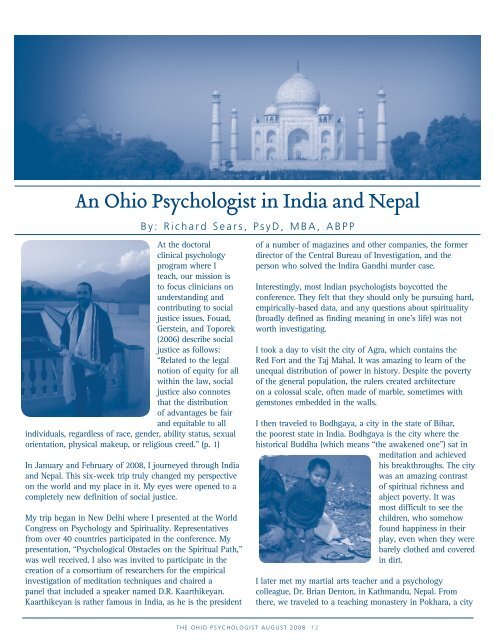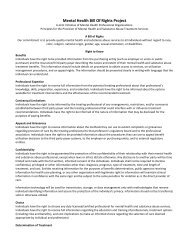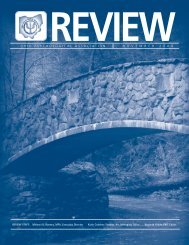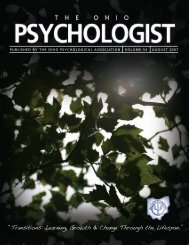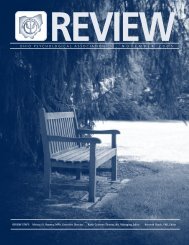2008 Ohio Psychologist - Ohio Psychological Association
2008 Ohio Psychologist - Ohio Psychological Association
2008 Ohio Psychologist - Ohio Psychological Association
You also want an ePaper? Increase the reach of your titles
YUMPU automatically turns print PDFs into web optimized ePapers that Google loves.
An <strong>Ohio</strong> <strong>Psychologist</strong> in India and Nepal<br />
At the doctoral<br />
clinical psychology<br />
program where I<br />
teach, our mission is<br />
to focus clinicians on<br />
understanding and<br />
contributing to social<br />
justice issues. Fouad,<br />
Gerstein, and Toporek<br />
(2006) describe social<br />
justice as follows:<br />
“Related to the legal<br />
notion of equity for all<br />
within the law, social<br />
justice also connotes<br />
that the distribution<br />
of advantages be fair<br />
and equitable to all<br />
individuals, regardless of race, gender, ability status, sexual<br />
orientation, physical makeup, or religious creed.” (p. 1)<br />
In January and February of <strong>2008</strong>, I journeyed through India<br />
and Nepal. This six-week trip truly changed my perspective<br />
on the world and my place in it. My eyes were opened to a<br />
completely new definition of social justice.<br />
My trip began in New Delhi where I presented at the World<br />
Congress on Psychology and Spirituality. Representatives<br />
from over 40 countries participated in the conference. My<br />
presentation, “<strong>Psychological</strong> Obstacles on the Spiritual Path,”<br />
was well received. I also was invited to participate in the<br />
creation of a consortium of researchers for the empirical<br />
investigation of meditation techniques and chaired a<br />
panel that included a speaker named D.R. Kaarthikeyan.<br />
Kaarthikeyan is rather famous in India, as he is the president<br />
By: Richard Sears, PsyD, MBA, ABPP<br />
of a number of magazines and other companies, the former<br />
director of the Central Bureau of Investigation, and the<br />
person who solved the Indira Gandhi murder case.<br />
Interestingly, most Indian psychologists boycotted the<br />
conference. They felt that they should only be pursuing hard,<br />
empirically-based data, and any questions about spirituality<br />
(broadly defined as finding meaning in one’s life) was not<br />
worth investigating.<br />
I took a day to visit the city of Agra, which contains the<br />
Red Fort and the Taj Mahal. It was amazing to learn of the<br />
unequal distribution of power in history. Despite the poverty<br />
of the general population, the rulers created architecture<br />
on a colossal scale, often made of marble, sometimes with<br />
gemstones embedded in the walls.<br />
I then traveled to Bodhgaya, a city in the state of Bihar,<br />
the poorest state in India. Bodhgaya is the city where the<br />
historical Buddha (which means “the awakened one”) sat in<br />
meditation and achieved<br />
his breakthroughs. The city<br />
was an amazing contrast<br />
of spiritual richness and<br />
abject poverty. It was<br />
most difficult to see the<br />
children, who somehow<br />
found happiness in their<br />
play, even when they were<br />
barely clothed and covered<br />
in dirt.<br />
I later met my martial arts teacher and a psychology<br />
colleague, Dr. Brian Denton, in Kathmandu, Nepal. From<br />
there, we traveled to a teaching monastery in Pokhara, a city<br />
THE OHIO PSYCHOLOGIST AUGUST <strong>2008</strong> 12


